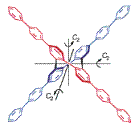Chemistry, Department of: Faculty Series

Andrzej Rajca Publications
Document Type
Article
Date of this Version
November 2007
Abstract
Chirality is increasingly important in the design of organic π-conjugated materials. One of the aspects of the design involves optimization of achiral properties through the introduction of chirality. In this context, the inherent three-dimensional character of chirality and the control of intermolecular interactions associated with diastereomeric recognition provide a versatile handle for the optimization of supramolecular structures, film morphology and liquid crystalline order of π-conjugated polymers and oligomers in three dimensions. These inherently achiral properties have an impact on optoelectronic coupling, which may affect the fabrication of light-emitting diodes, field effect transistors, photodiodes, photovoltaic cells, fluorescent sensors and other devices. Another aspect of the design involves optimization of chiral counterparts of properties in optics (circular polarization of light), electronics (chiral transport of charge carriers), etc. The challenge in this area is to obtain materials with inherently strong chiral properties at the macromolecular level, rather than derived from an aggregate or a supramolecular structure. Such inherently strong chiral properties, approaching or exceeding in magnitude their achiral counterparts, would facilitate exploration of chiral properties of single molecule devices and the design of novel chiral materials.
For typical π-conjugated polymers, helical conformation in the π-conjugated backbone may be induced via the chiral nonracemic pendants, complexation of a chiral nonracemic compound or polymerization in chiral nematic liquid crystal (LC). There are few structural motifs for nonracemic polymers with configurationally stable helical (and formally cross-conjugated) backbones such as polyisocyanides or with in-chain π-conjugated chirality. However, the majority, if not all, of π-conjugated polymers only display significant nonracemic helicity in an aggregated or ordered form.
The introduction of angular connectors (e.g. 1,3-phenylenes, 2,7-naphthylenes) in the π-conjugated backbones may provide an oligomer with a preferred helical conformation. The nonracemic helicity of such foldamers, which may be induced via chiral nonracemic pendants or in-chain chirality (e.g. 1,1'-binaphthyls, [4]helicenes), is also associated with an aggregated form and it is solvent dependent.
Another class of polymers and oligomers possess highly annelated (e.g. ladder-type) chiral π-conjugated systems. The oligomers with helical, ladder-type π-conjugated systems were found to be among molecules with the strongest chiral properties. Whereas helical polymers with ladder-type connectivity have been prepared with varied degrees of success, a highly extended helical ladder-type π-conjugated system has not been attained.
This chapter addresses synthetic aspects of molecules with highly annelated chiral π-conjugated systems, with the focus on helicene-type oligomers. In addition to synthesis, configurational stability (barriers for racemization) and selected chiroptical properties of such molecules will be discussed.


Comments
Published in Functional Organic Materials. Syntheses, Strategies, and Applications, edited by Thomas J.J. Müller and Uwe H.F. Bunz (Weinheim, Germany: WILEY-VCH Verlag GmbH & Co. KGaA, 2007), as Chapter 15, pages 547–581. ISBN: 978-3-527-31302-0 Copyright © 2007 WILEY-VCH Verlag GmbH & Co. KGaA. Used by permission.